belt VOLVO V70 1999 Owners Manual
[x] Cancel search | Manufacturer: VOLVO, Model Year: 1999, Model line: V70, Model: VOLVO V70 1999Pages: 61, PDF Size: 0.88 MB
Page 1 of 61
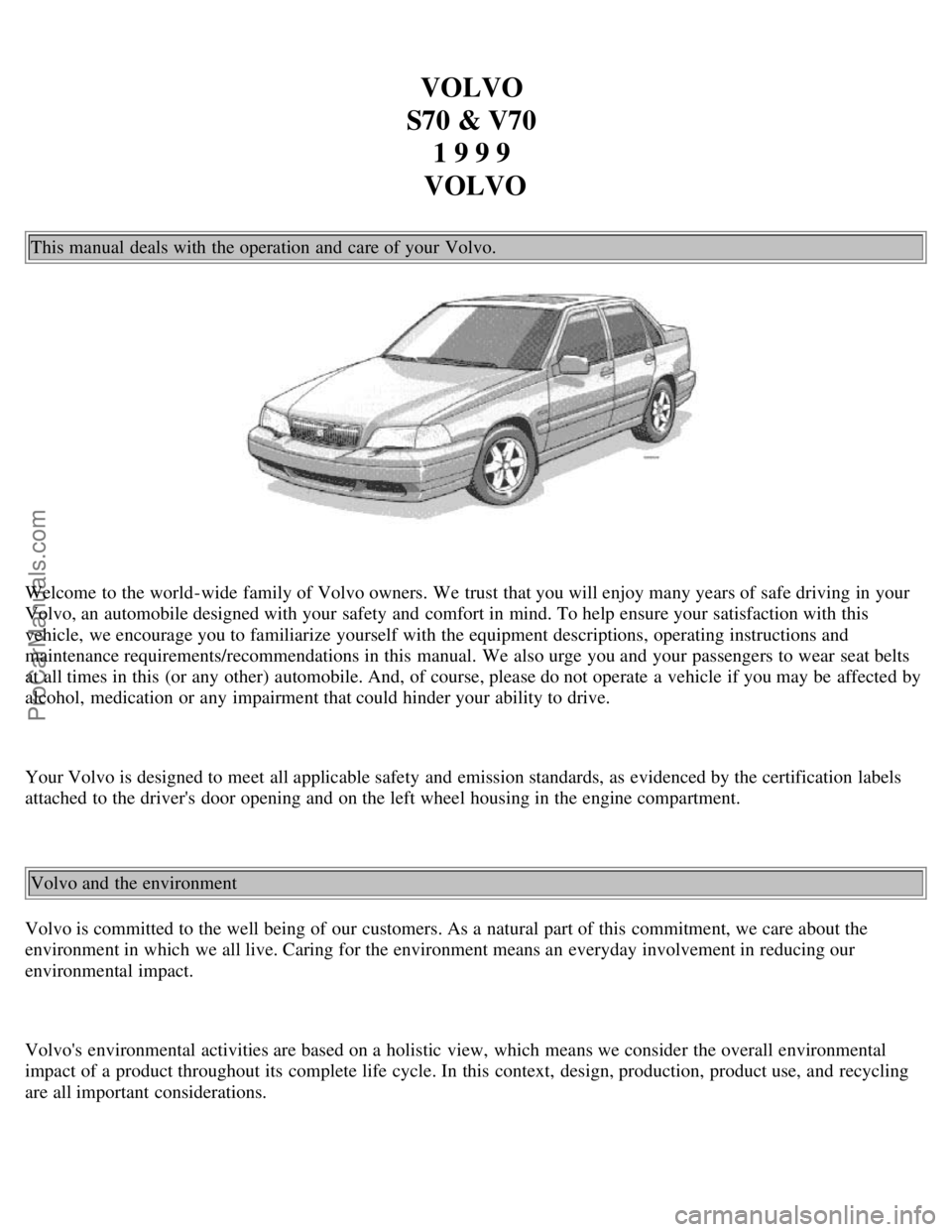
VOLVO
S70 & V70 1 9 9 9
VOLVO
This manual deals with the operation and care of your Volvo.
Welcome to the world-wide family of Volvo owners. We trust that you will enjoy many years of safe driving in your
Volvo, an automobile designed with your safety and comfort in mind. To help ensure your satisfaction with this
vehicle, we encourage you to familiarize yourself with the equipment descriptions, operating instructions and
maintenance requirements/recommendations in this manual. We also urge you and your passengers to wear seat belts
at all times in this (or any other) automobile. And, of course, please do not operate a vehicle if you may be affected by
alcohol, medication or any impairment that could hinder your ability to drive.
Your Volvo is designed to meet all applicable safety and emission standards, as evidenced by the certification labels
attached to the driver's door opening and on the left wheel housing in the engine compartment.
Volvo and the environment
Volvo is committed to the well being of our customers. As a natural part of this commitment, we care about the
environment in which we all live. Caring for the environment means an everyday involvement in reducing our
environmental impact.
Volvo's environmental activities are based on a holistic view, which means we consider the overall environmental
impact of a product throughout its complete life cycle. In this context, design, production, product use, and recycling
are all important considerations.
ProCarManuals.com
Page 4 of 61
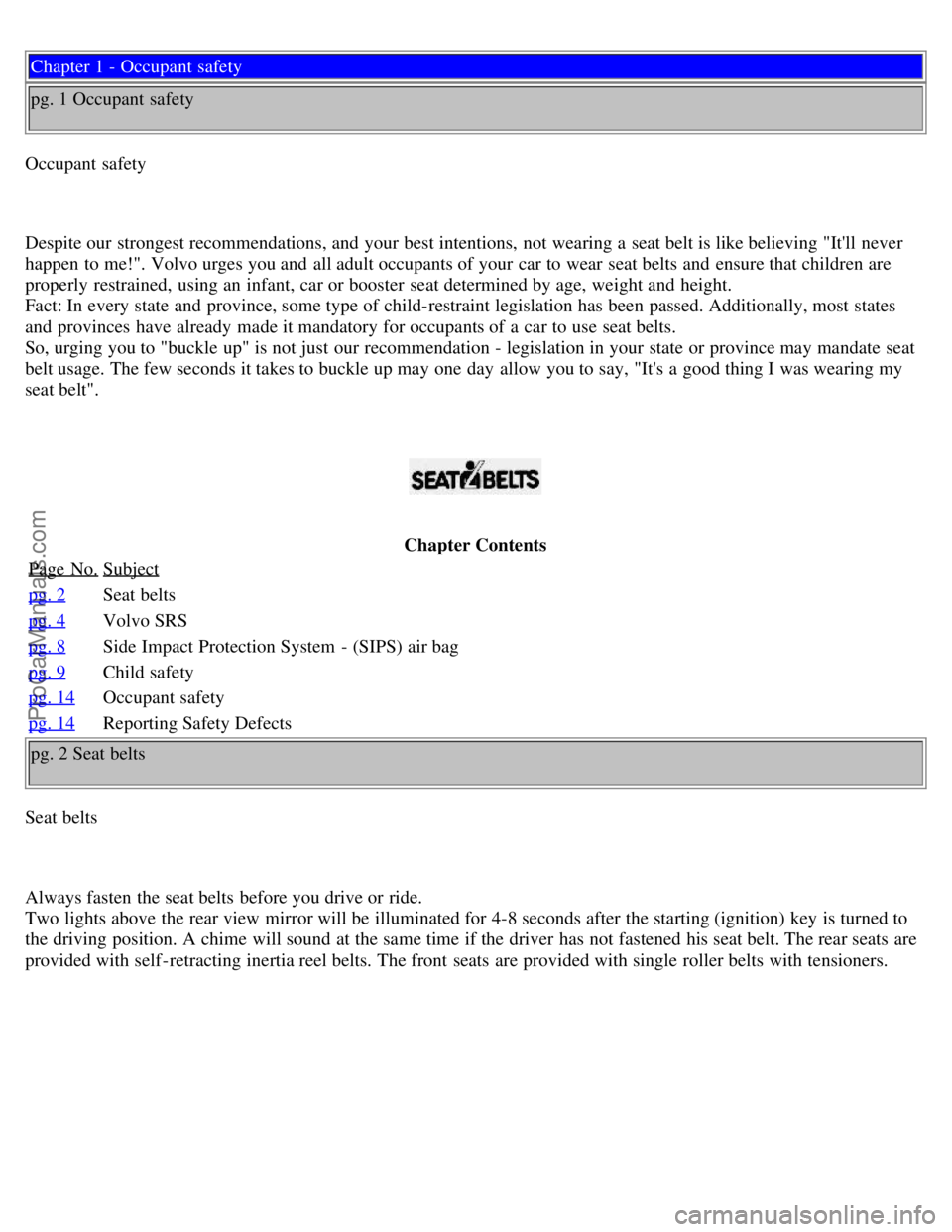
Chapter 1 - Occupant safety
pg. 1 Occupant safety
Occupant safety
Despite our strongest recommendations, and your best intentions, not wearing a seat belt is like believing "It'll never
happen to me!". Volvo urges you and all adult occupants of your car to wear seat belts and ensure that children are
properly restrained, using an infant, car or booster seat determined by age, weight and height.
Fact: In every state and province, some type of child-restraint legislation has been passed. Additionally, most states
and provinces have already made it mandatory for occupants of a car to use seat belts.
So, urging you to "buckle up" is not just our recommendation - legislation in your state or province may mandate seat
belt usage. The few seconds it takes to buckle up may one day allow you to say, "It's a good thing I was wearing my
seat belt".
Chapter Contents
Page No.
Subject
pg. 2Seat belts
pg. 4
Volvo SRS
pg. 8
Side Impact Protection System - (SIPS) air bag
pg. 9
Child safety
pg. 14
Occupant safety
pg. 14
Reporting Safety Defects
pg. 2 Seat belts
Seat belts
Always fasten the seat belts before you drive or ride.
Two lights above the rear view mirror will be illuminated for 4-8 seconds after the starting (ignition) key is turned to
the driving position. A chime will sound at the same time if the driver has not fastened his seat belt. The rear seats are
provided with self -retracting inertia reel belts. The front seats are provided with single roller belts with tensioners.
ProCarManuals.com
Page 5 of 61
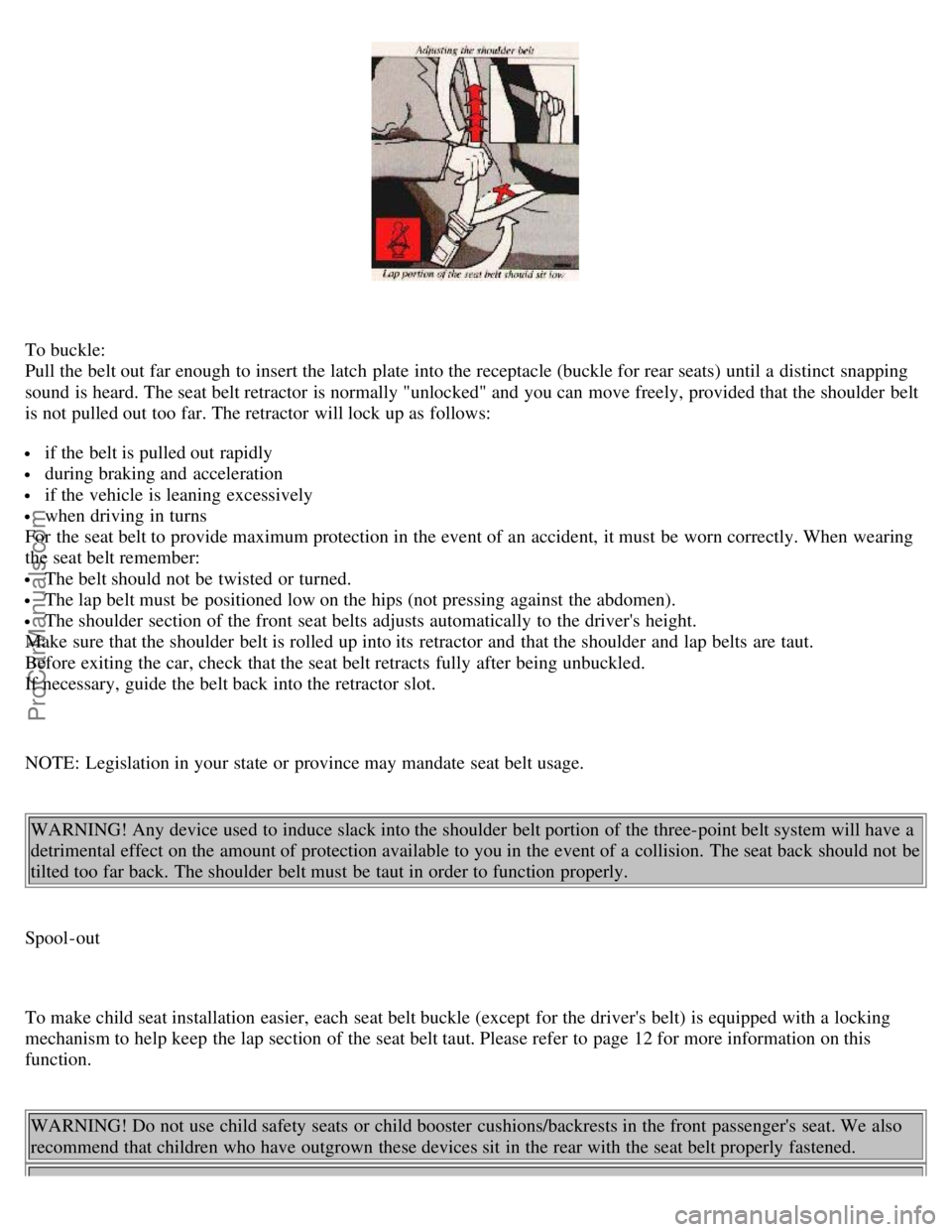
To buckle:
Pull the belt out far enough to insert the latch plate into the receptacle (buckle for rear seats) until a distinct snapping
sound is heard. The seat belt retractor is normally "unlocked" and you can move freely, provided that the shoulder belt
is not pulled out too far. The retractor will lock up as follows:
if the belt is pulled out rapidly
during braking and acceleration
if the vehicle is leaning excessively
when driving in turns
For the seat belt to provide maximum protection in the event of an accident, it must be worn correctly. When wearing
the seat belt remember:
The belt should not be twisted or turned.
The lap belt must be positioned low on the hips (not pressing against the abdomen).
The shoulder section of the front seat belts adjusts automatically to the driver's height.
Make sure that the shoulder belt is rolled up into its retractor and that the shoulder and lap belts are taut.
Before exiting the car, check that the seat belt retracts fully after being unbuckled.
If necessary, guide the belt back into the retractor slot.
NOTE: Legislation in your state or province may mandate seat belt usage.
WARNING! Any device used to induce slack into the shoulder belt portion of the three-point belt system will have a
detrimental effect on the amount of protection available to you in the event of a collision. The seat back should not be
tilted too far back. The shoulder belt must be taut in order to function properly.
Spool-out
To make child seat installation easier, each seat belt buckle (except for the driver's belt) is equipped with a locking
mechanism to help keep the lap section of the seat belt taut. Please refer to page 12 for more information on this
function. WARNING! Do not use child safety seats or child booster cushions/backrests in the front passenger's seat. We also
recommend that children who have outgrown these devices sit in the rear with the seat belt properly fastened.
ProCarManuals.com
Page 6 of 61
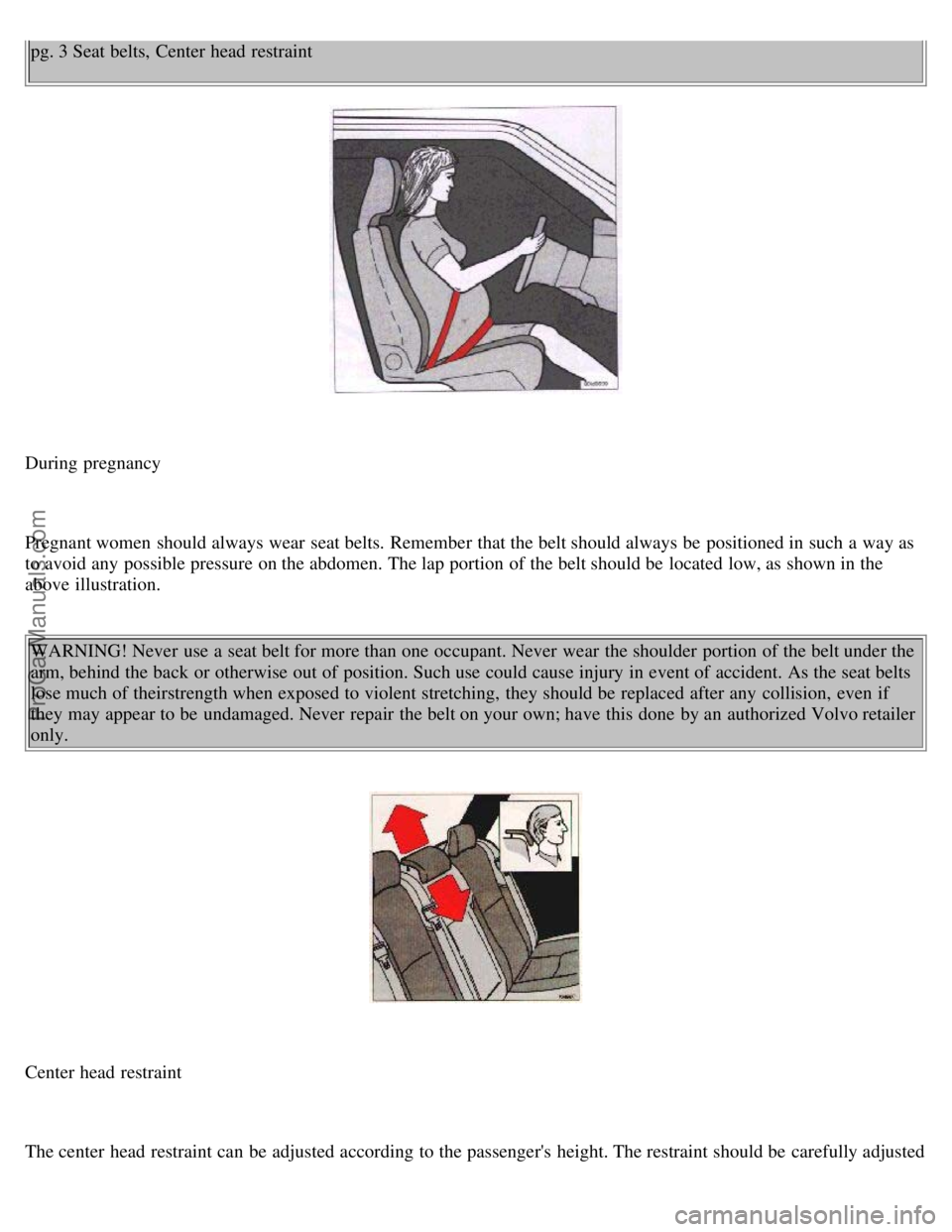
pg. 3 Seat belts, Center head restraint
During pregnancy
Pregnant women should always wear seat belts. Remember that the belt should always be positioned in such a way as
to avoid any possible pressure on the abdomen. The lap portion of the belt should be located low, as shown in the
above illustration.WARNING! Never use a seat belt for more than one occupant. Never wear the shoulder portion of the belt under the
arm, behind the back or otherwise out of position. Such use could cause injury in event of accident. As the seat belts
lose much of theirstrength when exposed to violent stretching, they should be replaced after any collision, even if
they may appear to be undamaged. Never repair the belt on your own; have this done by an authorized Volvo retailer
only.
Center head restraint
The center head restraint can be adjusted according to the passenger's height. The restraint should be carefully adjusted
ProCarManuals.com
Page 36 of 61
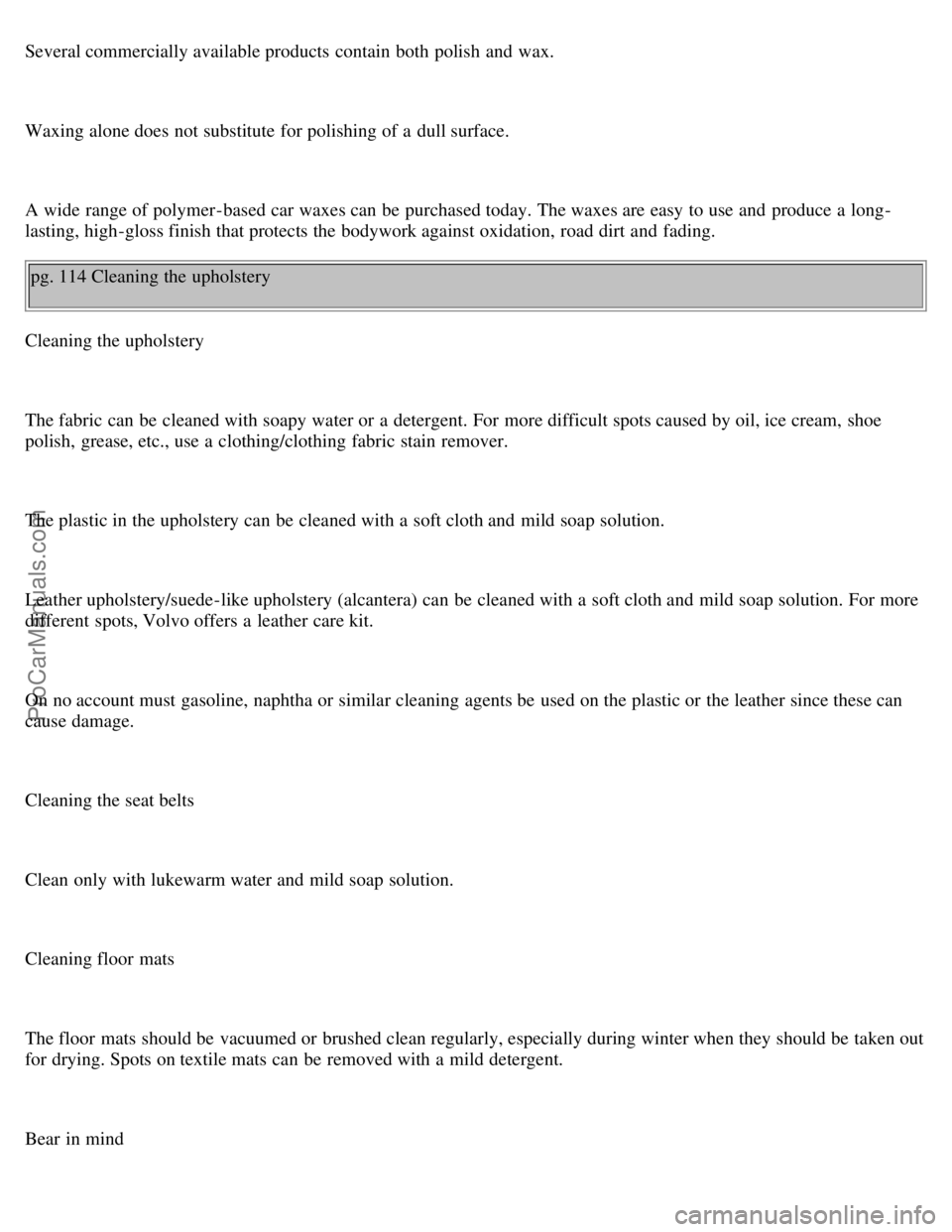
Several commercially available products contain both polish and wax.
Waxing alone does not substitute for polishing of a dull surface.
A wide range of polymer-based car waxes can be purchased today. The waxes are easy to use and produce a long-
lasting, high-gloss finish that protects the bodywork against oxidation, road dirt and fading.pg. 114 Cleaning the upholstery
Cleaning the upholstery
The fabric can be cleaned with soapy water or a detergent. For more difficult spots caused by oil, ice cream, shoe
polish, grease, etc., use a clothing/clothing fabric stain remover.
The plastic in the upholstery can be cleaned with a soft cloth and mild soap solution.
Leather upholstery/suede-like upholstery (alcantera) can be cleaned with a soft cloth and mild soap solution. For more
different spots, Volvo offers a leather care kit.
On no account must gasoline, naphtha or similar cleaning agents be used on the plastic or the leather since these can
cause damage.
Cleaning the seat belts
Clean only with lukewarm water and mild soap solution.
Cleaning floor mats
The floor mats should be vacuumed or brushed clean regularly, especially during winter when they should be taken out
for drying. Spots on textile mats can be removed with a mild detergent.
Bear in mind
ProCarManuals.com
Page 38 of 61
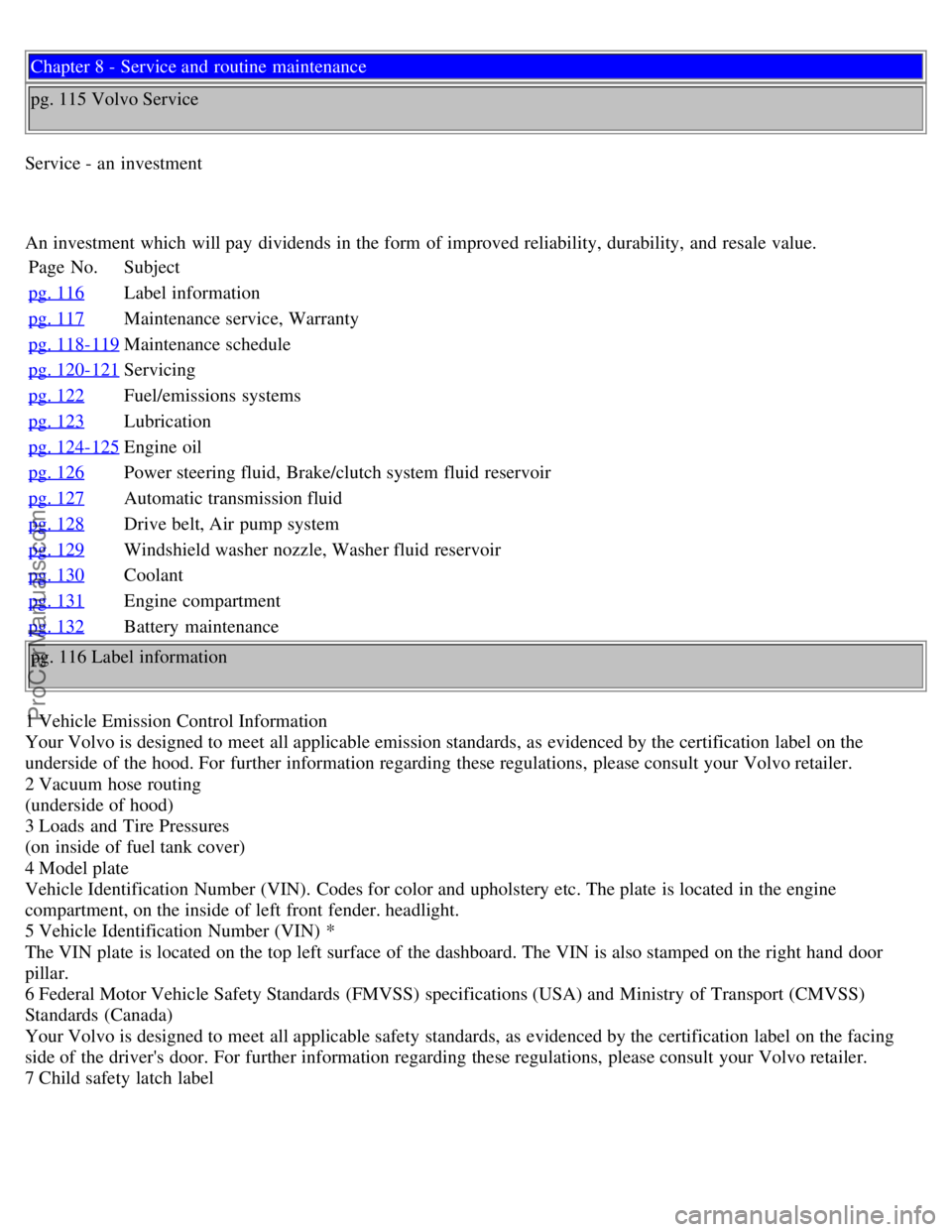
Chapter 8 - Service and routine maintenance
pg. 115 Volvo Service
Service - an investment
An investment which will pay dividends in the form of improved reliability, durability, and resale value. Page No. Subject
pg. 116
Label information
pg. 117
Maintenance service, Warranty
pg. 118-119
Maintenance schedule
pg. 120-121
Servicing
pg. 122
Fuel/emissions systems
pg. 123
Lubrication
pg. 124-125
Engine oil
pg. 126
Power steering fluid, Brake/clutch system fluid reservoir
pg. 127
Automatic transmission fluid
pg. 128
Drive belt, Air pump system
pg. 129
Windshield washer nozzle, Washer fluid reservoir
pg. 130
Coolant
pg. 131
Engine compartment
pg. 132
Battery maintenance
pg. 116 Label information
1 Vehicle Emission Control Information
Your Volvo is designed to meet all applicable emission standards, as evidenced by the certification label on the
underside of the hood. For further information regarding these regulations, please consult your Volvo retailer.
2 Vacuum hose routing
(underside of hood)
3 Loads and Tire Pressures
(on inside of fuel tank cover)
4 Model plate
Vehicle Identification Number (VIN). Codes for color and upholstery etc. The plate is located in the engine
compartment, on the inside of left front fender. headlight.
5 Vehicle Identification Number (VIN) *
The VIN plate is located on the top left surface of the dashboard. The VIN is also stamped on the right hand door
pillar.
6 Federal Motor Vehicle Safety Standards (FMVSS) specifications (USA) and Ministry of Transport (CMVSS)
Standards (Canada)
Your Volvo is designed to meet all applicable safety standards, as evidenced by the certification label on the facing
side of the driver's door. For further information regarding these regulations, please consult your Volvo retailer.
7 Child safety latch label
ProCarManuals.com
Page 40 of 61
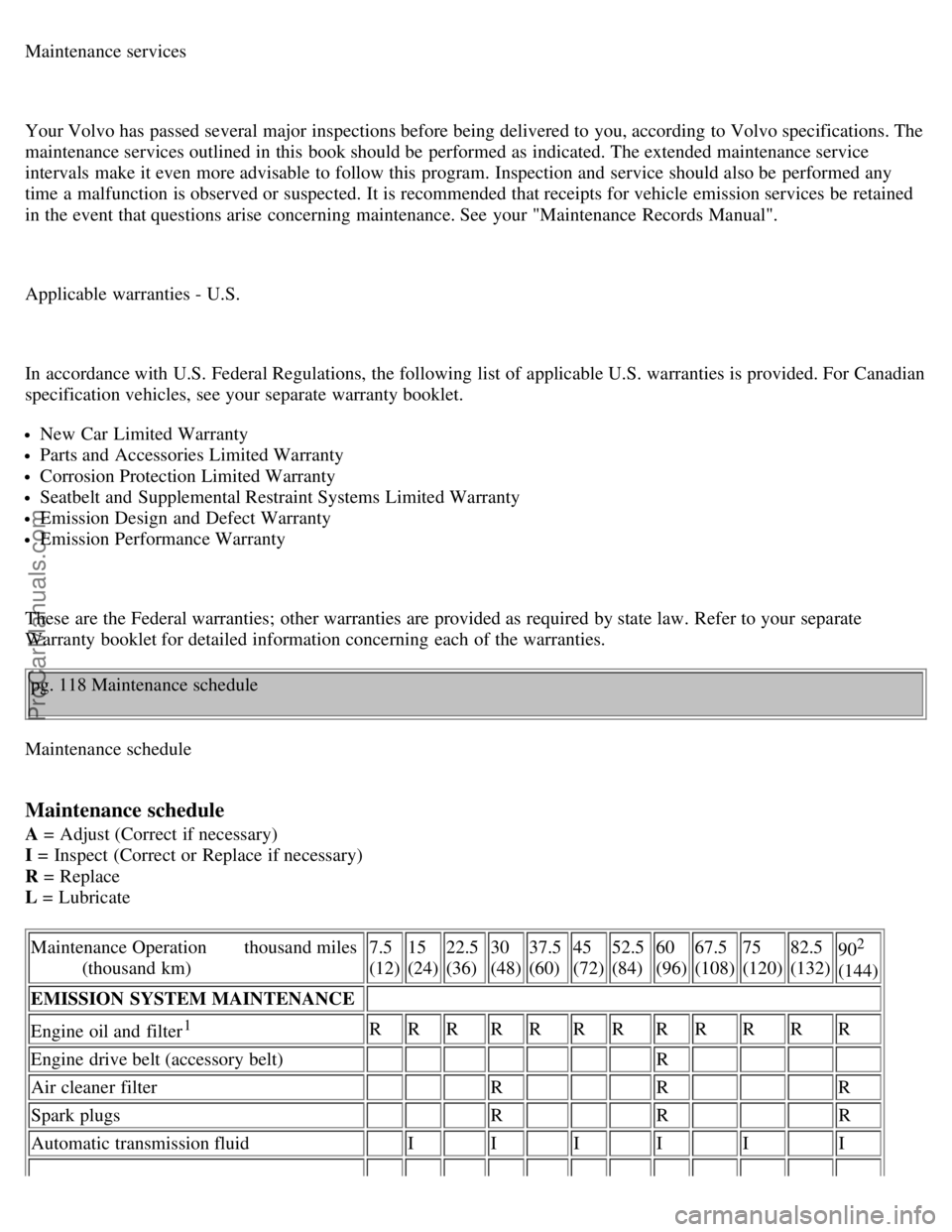
Maintenance services
Your Volvo has passed several major inspections before being delivered to you, according to Volvo specifications. The
maintenance services outlined in this book should be performed as indicated. The extended maintenance service
intervals make it even more advisable to follow this program. Inspection and service should also be performed any
time a malfunction is observed or suspected. It is recommended that receipts for vehicle emission services be retained
in the event that questions arise concerning maintenance. See your "Maintenance Records Manual".
Applicable warranties - U.S.
In accordance with U.S. Federal Regulations, the following list of applicable U.S. warranties is provided. For Canadian
specification vehicles, see your separate warranty booklet.
New Car Limited Warranty
Parts and Accessories Limited Warranty
Corrosion Protection Limited Warranty
Seatbelt and Supplemental Restraint Systems Limited Warranty
Emission Design and Defect Warranty
Emission Performance Warranty
These are the Federal warranties; other warranties are provided as required by state law. Refer to your separate
Warranty booklet for detailed information concerning each of the warranties. pg. 118 Maintenance schedule
Maintenance schedule
Maintenance schedule
A = Adjust (Correct if necessary)
I = Inspect (Correct or Replace if necessary)
R = Replace
L = Lubricate
Maintenance Operation thousand miles
(thousand km) 7.5
(12)15
(24)22.5
(36) 30
(48)37.5
(60) 45
(72)52.5
(84) 60
(96)67.5
(108) 75
(120)82.5
(132)
90
2
(144)
EMISSION SYSTEM MAINTENANCE
Engine oil and filter
1R RR RR RR RR RRR
Engine drive belt (accessory belt) R
Air cleaner filter R R R
Spark plugs R R R
Automatic transmission fluid I I I I I I
ProCarManuals.com
Page 41 of 61
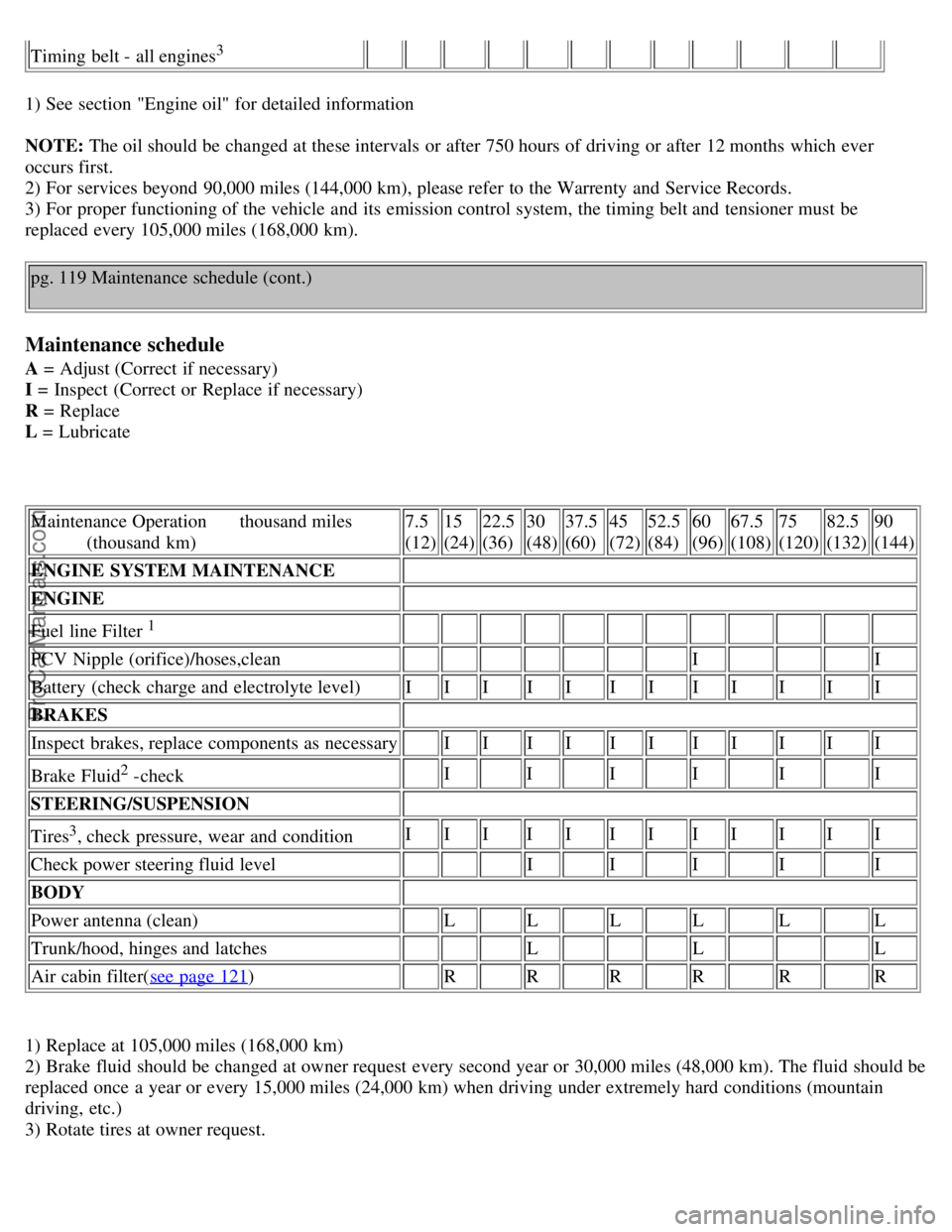
Timing belt - all engines3
1) See section "Engine oil" for detailed information
NOTE: The oil should be changed at these intervals or after 750 hours of driving or after 12 months which ever
occurs first.
2) For services beyond 90,000 miles (144,000 km), please refer to the Warrenty and Service Records.
3) For proper functioning of the vehicle and its emission control system, the timing belt and tensioner must be
replaced every 105,000 miles (168,000 km).
pg. 119 Maintenance schedule (cont.)
Maintenance schedule
A = Adjust (Correct if necessary)
I = Inspect (Correct or Replace if necessary)
R = Replace
L = Lubricate
Maintenance Operation thousand miles
(thousand km) 7.5
(12)15
(24)22.5
(36) 30
(48)37.5
(60) 45
(72)52.5
(84) 60
(96)67.5
(108) 75
(120)82.5
(132)90
(144)
ENGINE SYSTEM MAINTENANCE
ENGINE
Fuel line Filter
1
PCV Nipple (orifice)/hoses,clean I I
Battery (check charge and electrolyte level) III II II II III
BRAKES
Inspect brakes, replace components as necessary II II II II III
Brake Fluid
2 -check
I I I I I I
STEERING/SUSPENSION
Tires
3, check pressure, wear and condition I
II II II II III
Check power steering fluid level I I I I I
BODY
Power antenna (clean) L L L L L L
Trunk/hood, hinges and latches L L L
Air cabin filter( see page 121
) R R R R R R
1) Replace at 105,000 miles (168,000 km)
2) Brake fluid should be changed at owner request every second year or 30,000 miles (48,000 km). The fluid should be
replaced once a year or every 15,000 miles (24,000 km) when driving under extremely hard conditions (mountain
driving, etc.)
3) Rotate tires at owner request.
ProCarManuals.com
Page 56 of 61
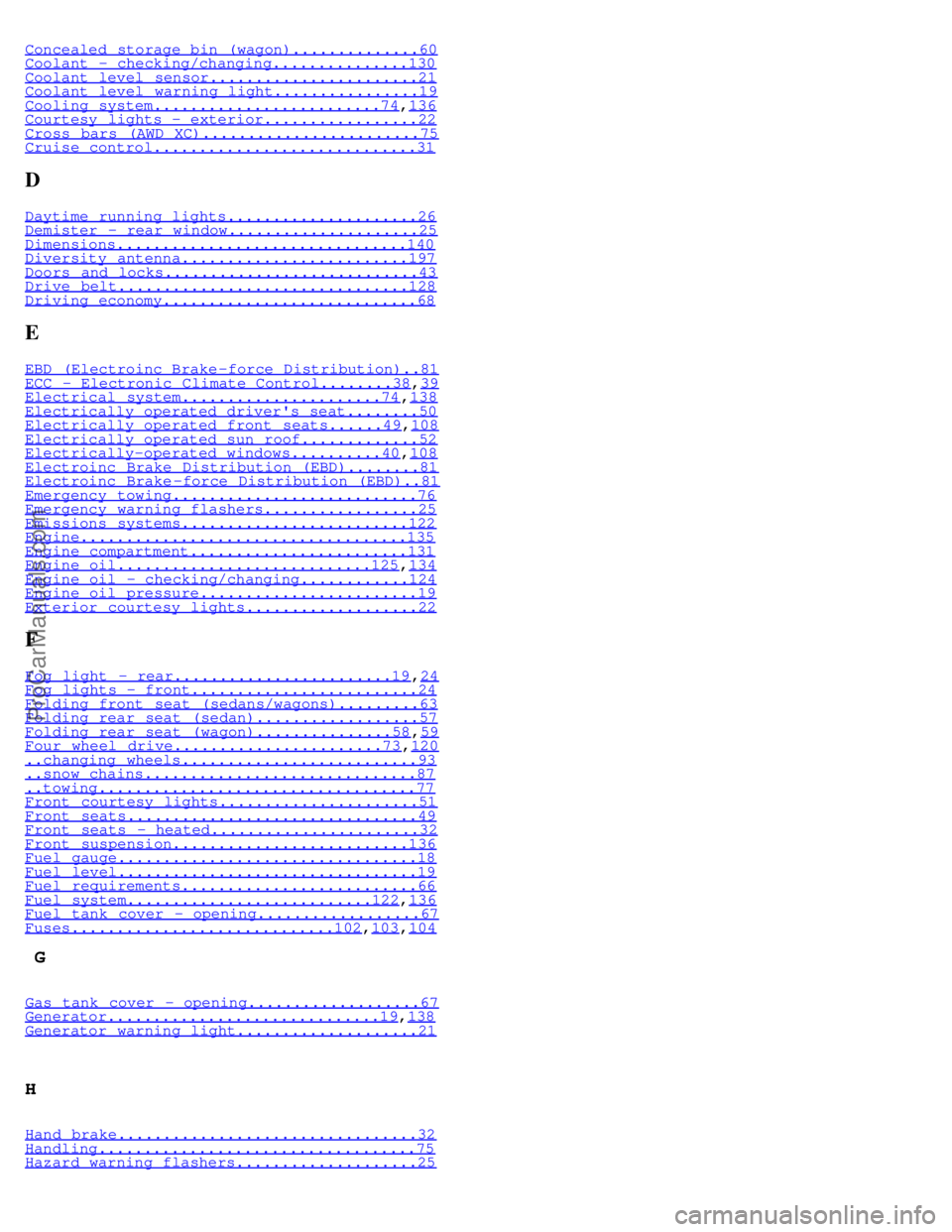
Concealed storage bin (wagon)..............60Coolant - checking/changing...............130Coolant level sensor.......................21Coolant level warning light................19Cooling system.........................74,136Courtesy lights - exterior.................22Cross bars (AWD XC)........................75Cruise control.............................31
D
Daytime running lights.....................26Demister - rear window.....................25Dimensions................................140Diversity antenna.........................197Doors and locks............................43Drive belt................................128Driving economy............................68
E
EBD (Electroinc Brake -force Distribution)..81ECC - Electronic Climate Control........38,39Electrical system......................74,138Electrically operated driver's seat........50Electrically operated front seats......49,108Electrically operated sun roof.............52Electrically-operated windows..........40,108Electroinc Brake Distribution (EBD)........81Electroinc Brake -force Distribution (EBD)..81Emergency towing...........................76Emergency warning flashers.................25Emissions systems.........................122Engine....................................135Engine compartment........................131Engine oil............................125,134Engine oil - checking/changing............124Engine oil pressure........................19Exterior courtesy lights...................22
F
Fog light - rear........................19,24Fog lights - front.........................24Folding front seat (sedans/wagons).........63Folding rear seat (sedan)..................57Folding rear seat (wagon)...............58,59Four wheel drive.......................73,120..changing wheels..........................93..snow chains..............................87..towing...................................77Front courtesy lights......................51Front seats................................49Front seats - heated.......................32Front suspension..........................136Fuel gauge.................................18Fuel level.................................19Fuel requirements..........................66Fuel system...........................122,136Fuel tank cover - opening..................67Fuses.............................102,103,104
G
Gas tank cover - opening...................67Generator..............................19,138Generator warning light....................21
H
Hand brake.................................32Handling...................................75Hazard warning flashers....................25
ProCarManuals.com
Page 58 of 61
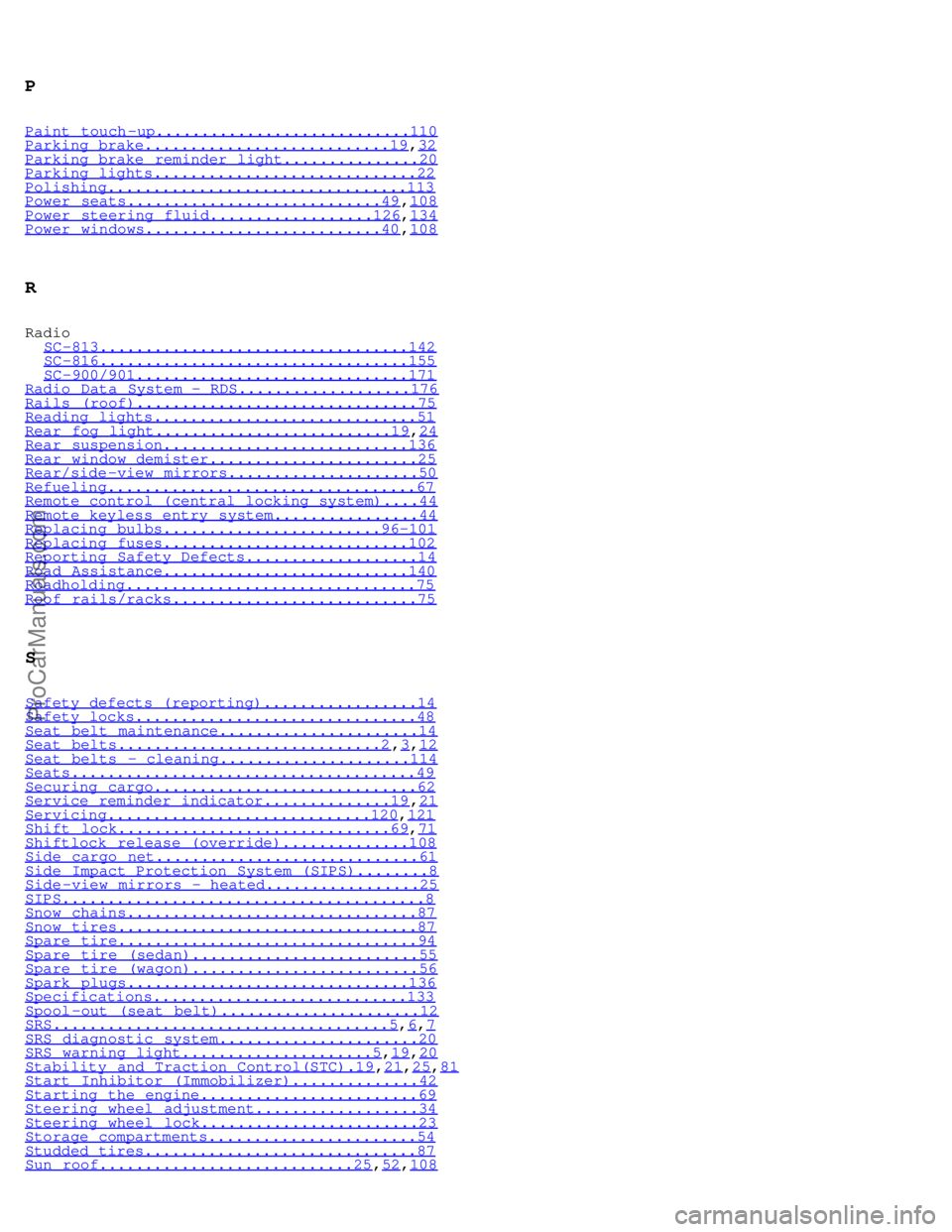
P
Paint touch -up............................110Parking brake...........................19,32Parking brake reminder light...............20Parking lights.............................22Polishing.................................113Power seats............................49,108Power steering fluid..................126,134Power windows..........................40,108
R
Radio
SC-813..................................142
SC-816..................................155 SC-900/901..............................171Radio Data System - RDS...................176Rails (roof)...............................75Reading lights.............................51Rear fog light..........................19,24Rear suspension...........................136Rear window demister.......................25Rear/side -view mirrors.....................50Refueling..................................67Remote control (central locking system)....44Remote keyless entry system................44Replacing bulbs........................96-101Replacing fuses...........................102Reporting Safety Defects...................14Road Assistance...........................140Roadholding................................75Roof rails/racks...........................75
S
Safety defects (reporting).................14Safety locks...............................48Seat belt maintenance......................14Seat belts.............................2,3,12Seat belts - cleaning.....................114Seats......................................49Securing cargo.............................62Service reminder indicator..............19,21Servicing.............................120,121Shift lock..............................69,71Shiftlock release (override)..............108Side cargo net.............................61Side Impact Protection System (SIPS)........8Side -view mirrors - heated.................25SIPS........................................8Snow chains................................87Snow tires.................................87Spare tire.................................94Spare tire (sedan).........................55Spare tire (wagon).........................56Spark plugs...............................136Specifications............................133Spool -out (seat belt)......................12SRS.....................................5,6,7SRS diagnostic system......................20SRS warning light.....................5,19,20Stability and Traction Control(STC).19,21,25,81Start Inhibitor (Immobilizer)..............42Starting the engine........................69Steering wheel adjustment..................34Steering wheel lock........................23Storage compartments.......................54Studded tires..............................87Sun roof............................25,52,108
ProCarManuals.com